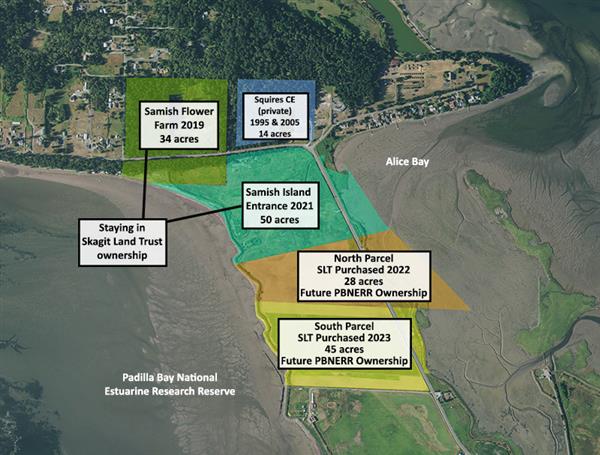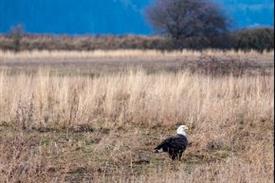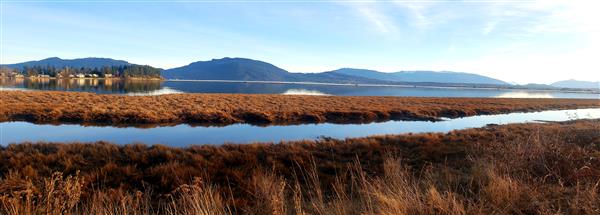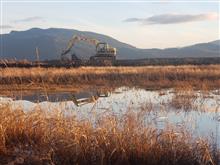For the past 25 years Skagit Land Trust (the Trust) has been working to conserve the land and waters at the entrance to Samish Island. We began with private landowners donating conservation easements on forested uplands. We purchased the Samish Flower Farm in 2019 and the Samish Island Entrance Property in 2021, which together form the Samish Island Conservation Area. In December, the Trust bought 28 adjacent acres. This spring, the Trust purchased another 45 acres. This brings the total conserved lands at the entrance of Samish Island to 171 acres.
The recent purchases of 28 and 45 acres were possible thanks to a partnership with the Padilla Bay National Estuary Research Reserve (PBNERR). The Trust was able to act quickly when the two properties came on the market, thanks to member donations, Trust funds, and a loan from The Conservation Fund. While Skagit Land Trust ensured that the properties were protected today, PBNERRS worked with the Washington State Department of Ecology to apply for a federal grant to purchase the lands from the Trust for long-term ownership and conservation.
On Friday, April 21st, the National Oceanic and Atmospheric Administration announced that PBNERR's grant would be fully funded as part of Bipartisan Infrastructure Law, with funds leveraged from the Inflation Reduction Act. The grant will allow Padilla Bay National Estuarine Research Reserve to protect and restore acres of former and current tidal marsh, as part of a larger overall effort with Skagit Land Trust to restore up to 105 acres of tidal marsh to Padilla Bay.
The main focus of the project is to increase climate resilience. The project will also restore tribal cultural connections with the site, which is near an important historical longhouse location. Securing the land and exploring restoration options, allows for all stakeholders to propose a habitat restoration and improved access project in the face of climate change.
"We are thrilled that Padilla Bay National Estuarine Research Reserve was selected for this award," says Trust Executive Director, Molly Doran. "It is an important step in the project we have been working on for many years to conserve areas near Samish Island in what was historically a slough and tidal marsh environment. The award moves our partnership a large step forward as key properties can now be permanently protected. Yet we want to do much more and this award also assists us in exploring restoration options of this frequently flooded and increasingly salt impaired area. Restoration will increase coastal resilience to climate change. The community, our members and partners, such as The Conservation Fund, and the Samish Indian Nation, are also playing pivotal roles in this long-term, exciting project."

The property PBNERR will protect with this grant features nearly a mile of shoreline on Padilla and Alice Bays. The tidelands outside the dikes include some salt marsh on Alice Bay. This gives us a glimpse of the habitat, now rare, that once made up most of the approach to the Island. The land that was created between the dikes has been farmed with various crops and grasses and is terrific bird habitat. It also serves as the only overland access to Samish Island.
.jpg&size=275)   |
| Left to right: Salt Marsh on Samish Bay; A multitude of wildlife use the property for feeding and shelter. Bald eagles, great blue herons, and migrating Brandt ducks are a few of the many species that use this land. |
 |
Skagit Land Trust has been planning for long-term restoration efforts at the Samish Island Conservation Area. In 2022, the Trust hired Blue Coast Engineering to begin a site assessment and restoration feasibility study of the lower portion of the Samish Island Conservation Area. The area supports freshwater wetlands and sloughs, nearshore and forested habitats. The current phase of the project is evaluating the potential to restore saltwater to the project area without negative impacts to community members. The assessment will consider infrastructure, including the road and dikes, present on and adjacent to this property.
"Our partnership with PBNERRS will expand the scope of the assessment and restoration feasibility study to include the recently protected parcels," says Stewardship Director, Regina Wandler. "The Trust and PBNERR will review the study to determine how to move ahead on a marine shoreline restoration project on Samish Island."
Data collection has begun and will occur intermittently through fall 2024. The assessment includes groundwater and surface water hydrology, geology, vegetation, and coastal processes data collection. The Trust anticipates having a public meeting to share information about this effort with the community by fall of 2024.
"I am excited about the opportunity for the Trust to partner with the Padilla Bay National Estuarine Research Reserve to permanently protect this former and current tidal marsh habitat," says Conservation Project Manager Kari Odden. "We know that the Reserve and its staff share our passion for preserving the Samish Island Conservation Area. The Reserve plays a regionally recognized role as a center of coastal conservation research and will be a strong and trusted partner in ecological assessment and restoration planning."

For thousands of years the Coast Salish people approached Samish Island through a wide slough that connected two bays and was surrounded by tidal marsh. The slough was named S7amésh Seqelích (Coming Out of a Bay) by the Samish Indian Nation. In the 1930’s Skagit County put fill across the last quarter mile of marsh and slough to construct a new road near the Alice Bay (east) shoreline. A farmer diked his land to the west on Padilla Bay. And since then, Samish Island has been connected to the mainland by an isthmus.
The dynamic nature of this isthmus environment was on full view during king tides coupled with low barometric pressure in December. The dike on the Alice Bay side of the new property overtopped, flooding the county road to the island which now lies below sea level, and severely eroding the dike, putting it at risk of breaching. This dike, running alongside the road, is not in a dike district and lies on private land. Repairs on it had historically been done by the county to protect the road, however they said they could no longer take on a flood control role.
Due to the extreme situation, Skagit Land Trust stepped in to arrange and pay for the emergency repairs on the area at risk of breaching. In other areas of overtopping, volunteers sandbagged low spots. We are grateful for the help of local contractors- led by Arnie Svendsen Trucking Inc, Island residents, our members and volunteers including Steve Hopley who took a leadership role, and Dike District 5.
%20edits.jpg&size=340)   |
| King tides showed the age of the private dike. Trust staff met with community partners to begin talks on solutions to the aged dike. |
 |
The event served as a reminder that the marine environment is powerful. Climate change will also increasingly impact infrastructure. Conservation ownership of these lands provides significant benefit to the community. Skagit Land Trust’s growing conservation work on Samish Island has only been possible with the help of Trust members and volunteers, along with support from numerous partners including Coast Salish tribes such as the Samish Indian Nation, former landowners such as the Squires and Murphy families, conservation easement landowners, PBNERR, The Conservation Fund, other nonprofits, as well as local, state, and federal grant partners. Support from this extended community has played an important part in the conservation journey of the entrance to Samish Island.
For those wanting to visit the Samish Island Conservation Area, Skagit Land Trust continues to own the property with beach access via the trail from Samish Island Rd, and access there will remain open to the public. PBNERR is still developing their access policy for the property that will ultimately own. Until they purchase the parcels from Skagit Land Trust, those parcels will remain open for low impact, passive public access. The public should feel free to walk around the property and look at wildlife, but as always, remember to follow the Trust's visitor guidelines.
Click here the read the Skagit Valley Herald article